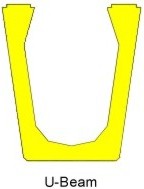

List of Prestressed Concrete Design Standards: [Show]
• EN 1991-1-1: Actions on Structures - General Actions
• EN 1991-1-4: Actions on Structures - Wind Actions
• EN 1991-1-5: Actions on Structures - Thermal Actions
• EN 1991-1-7: Actions on Structures - Accidental Actions
• EN 1991-2: Actions on Structures - Traffic Loads on Bridges
• EN 1992-1-1: Design of Concrete Structures - General Rules
• EN 1992-2: Design of Concrete Structures - Bridges
• Each document is accompanied by a National Annex
British Standards
• BS 5400: Part 2: Specification for Loads
• BS 5400: Part 4: Code of Practice for the Design of Concrete Bridges
• BS 5896: Specification for high tensile steel wire and strand for the
prestressing of concrete
• BS 8500: Concrete - Complementary British Standard to BS EN 206-1
• BS 8666: Specification for scheduling, dimensioning, bending and cutting
of steel reinforcement for concrete
Design Manual for Roads and Bridges
• BA24: Early Thermal Cracking of Concrete
• BD24: Design of Concrete Bridges
• BD28: Early Thermal Cracking of Concrete
• BD37: Loads for Highway Bridges
• BD43: Criteria and Materials for the Impregnation of Concrete Highway
Structures
• BD57 and BA57: Design for Durability
Technical Papers
• CIRIA Report C660 - Early-age thermal crack control in concrete.
Prestressed Concrete Decks
There are two types of deck using prestressed concrete :
Pre-tensioned beams with insitu concrete.
Post-tensioned concrete.
The term pre-tensioning is used to describe a method
of prestressing in which the tendons are tensioned before the concrete
is placed, and the prestress is transferred to the concrete when a suitable
cube strength is reached.
Post-tensioning is a method of prestressing in which the tendon is tensioned
after the concrete has reached a suitable strength. The tendons are anchored
against the hardened concrete immediately after prestressing.
There are three concepts involved in the design of prestressed concrete :
Prestressing transforms concrete into an elastic material.
By applying this concept concrete may be regarded as an elastic material, and may be treated as such for design at normal working loads. From this concept the criterion of no tensile stresses in the concrete was evolved.
In an economically designed simply supported beam, at the critical section, the bottom fibre stress under dead load and prestress should ideally be the maximum allowable stress; and under dead load, live load and prestress the stress should be the minimum allowable stress.
Therefore under dead load and prestress, as the dead load moment reduces towards the support, then the prestress moment will have to reduce accordingly to avoid exceeding the permissible stresses. In post-tensioned structures this may be achieved by curving the tendons, or in pre-tensioned structures some of the prestressing strands may be deflected or de-bonded near the support.Prestressed concrete is to be considered as a combination of steel and concrete with the steel taking tension and concrete compression so that the two materials form a resisting couple against the external moment. (Analogous to reinforced concrete concepts).
This concept is utilized to determine the ultimate strength of prestressed beams.Prestressing is used to achieve load balancing.
It is possible to arrange the tendons to produce an upward load which balances the downward load due to say, dead load, in which case the concrete would be in uniform compression.
Pre-tensioned Bridge Decks




Types of beams in common use are inverted T-beams, M-beams and Y beams. Inverted T-beams are generally used for spans between 7 and 16 metres and the voids between the beams are filled with insitu concrete thus forming a solid deck. M-Beams are used for spans between 14 and 30 metres and have a thin slab cast insitu spanning between the top flanges with the aim of forming a voided slab type deck. The top face of the bottom flange of M-Beams cannot be readily inspected, also the limited access makes bearing replacement difficult. As a consequence of these restrictions the Y-beam was introduced in 1990 to replace the M-beam. This lead to the production of an SY-beam which is used for spans between 32 and 40 metres. The U-beam is used for spans between 14 and 34 metres and is usually chosen where torsional strength is required.
Post-tensioned Bridge Decks
Post-tensioned bridge decks are generally composed of insitu concrete in which ducts have been cast in the required positions.



When the concrete has acquired sufficient strength, the
tendons are threaded through the ducts and tensioned by hydraulic jacks
acting against the ends of the member. The ends of the tendons are then
anchored.
Tendons are then bonded to the concrete by injecting grout into the ducts
after the stressing has been completed.
It is possible to use pre-cast concrete units which are post-tensioned
together on site to form the bridge deck.
Generally it is more economical to use post-tensioned construction for
continuous structures rather than insitu reinforced concrete at spans
greater than 20 metres. For simply supported spans it may be economic
to use a post-tensioned deck at spans greater than 20 metres.
Bridge Components | Choice of Deck
